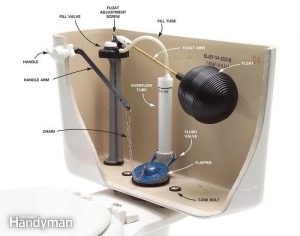How to Stop a Toilet That Keeps Running
According to EPA WaterSense, “the average household’s leaks can account for more than 10,000 gallons of water wasted every year, or the amount of water needed to wash 270 loads of laundry.”
The most common leaks come from leaking faucets, showerheads, and toilets. A constantly running or leaking toilet can easily waste over 200 gallons of water every single day. Fixing these easy-to-correct plumbing leaks in your home can cut about 10% off your water bill.
Another way you can reduce your household water waste is by installing low-flow plumbing fixtures, including more efficient low-flow toilets that use considerably less water for the same function.
Low-flow toilets use about 1.5 gallons per flush, while full flush toilets use an average of 3.5 gallons per flush. The higher-efficiency models are becoming the norm, but if you are thinking about replacing any of your toilets anytime soon, make sure you install a low-flow model.
Test for Toilet Leaks
Food Dye Test
One common and effective method of testing your toilet for leaks is the food dye test. Simply squeeze about 5 drops of food coloring into your toilet’s tank and wait about 30 minutes to see if any of the color appears in the toilet bowl. Remember not to flush the toilet during this time. If the food dye does appear in your toilet bowl, you have a leak somewhere between the tank and the bowl — most likely, it’s an issue with an old, worn-out, or loose-fitting toilet flapper.
Another way of telling if you have a toilet leak is by listening carefully to hear if any water is running, but the food dye test is more accurate.
How to Fix a Running Toilet
Source: Family Handyman
Use this image as a guide when going through the following steps.
1. Remove the toilet tank lid.
With the toilet tank lid removed, flush the toilet and inspect the toilet chain and flapper. Sometimes the chain is too long or too short to accomplish its function. It also may be tangled, which prevents the flapper from fully sealing the tank.
2. Turn the water off.
You can try to fix your toilet problem with a tank full of water, but we’re betting you’d like to keep things a little drier. Before you start trying to fix the toilet chain or flapper mechanism, turn the water off to your toilet. Locate the silver knob near the base of your toilet. Use your hand to tighten the valve so that you can’t turn it anymore. Flush the toilet one more time. If you have properly shut off the water, no more water should enter the toilet tank.
3. Fix the toilet chain.
If you have an issue with your toilet chain, you will either need to untangle it, remove some chain links with a wire cutter and pliers, or replace the chain entirely. If the chain is too long, it’s easy to move the clip at the end of the handle arm to a lower position on the chain. You can also adjust the length with a pair of wire cutters. Once the flapper can easily sit flush with the hole at the bottom of the tank, you should be good… unless you have a faulty flapper.
4. Fix the flapper.
Pay attention to the flapper when you flush your toilet. Is it getting stuck on anything? Is it connected properly? Is your flapper cracked or deteriorating?
If your flapper seems to be in good condition, check to see if you need to tighten it. You can do this by readjusting and tightening the bracket pegs at the end of the flush valve.
Even if you do fix the placement and tightness of the flapper, it still may not be able to secure a full seal. Toilet flappers, like everything else, have to be replaced eventually. If your flapper is soft and flimsy, cracked, or otherwise damaged, it’s time to find a replacement. Don’t worry, they are cheap to buy and easy to replace.
How to Replace a Toilet Flapper
With the water still turned off, and the toilet tank empty of water, use your hands to remove the toilet flapper from the pegs at the end of the flush valve. Use needle-nosed pliers to detach the flapper from the toilet chain.
Reverse the process to attach your new toilet flapper. First, connect it to the pegs, and then reattach the chain with your pliers. Make sure the flapper is properly secured and creating a full seal before turning the water back on.
Hopefully, you have fixed your running toilet by now! Turn the water back on, flush the toilet, and enjoy peace of mind and lower water bills.
When to Call the Professionals
Contact the plumbing professionals at Sobieski Services if you have any questions about a leaking or damaged toilet. If you have water gathering where the toilet meets the floor, don’t wait until there is mold and water damage to ask for help. Solving a toilet leak between the toilet horn and the drain line requires the expertise of a licensed plumber. These leaks can quickly rot floors, framing, and sometimes subfloors and underlayments.
Sobieski Services is here to solve all your plumbing problems. We’re happy to help. Contact us or call (855) 539-9252 today to schedule your appointment!








